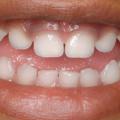 13 Things About Your Child's Teeth You May Not Have Known
13 Things About Your Child's Teeth You May Not Have Known
As your child's teeth come in, there are a few things that you should know to help keep teeth healthy.
1. Baby Teeth are Spaced Apart
As baby teeth come in, they usually have spaces between them. This is to make sure there is room for permanent teeth. The spaces are placeholders for the bigger teeth to take over in the future. When baby teeth are too close together, or no space exists, start saving up for braces :-).
2. Baby Teeth Help Children Learn to Chew and Talk
Baby teeth are not just the first set of teeth a human has, but a set of learning tools. Baby teeth help your children learn how to use their tongues and mouths for chewing and speaking. Without baby teeth, learning how to form certain sounds is almost impossible, making speech difficult.
3. Saliva Cleans Teeth
Saliva washes away bacteria and sugar from your teeth. That doesn't mean you shouldn't brush your teeth! Your saliva is just the first defense against cavities, but not the best one.
4. A Baby's Gums Should Be Brushed Like Teeth
A baby's gums should be cleaned as often as you would brush your teeth. Keeping gums clean and healthy will keep new teeth healthy as well. Use a soft cloth with water or a tiny amount of gum cleanser. Wipe down the gums after feedings and before bed times and naps.
5. Brush Your Child's Teeth Until They Are 8
Parents should help their kids brush their teeth until the age of 8. This is because children do not usually brush teeth well enough for long enough to prevent cavities. Kids should still get the chance to brush their own teeth though. Just have a parent brush them again afterward.
6. Grown Up and Still Cutting Teeth
The final permanent teeth or “wisdom teeth” emerge between 17-21 years of age. Wisdom teeth are frequently removed because they take up too much space in the mouth, or there is no room for them to come in.
7. Snacking Can Rot Teeth
Frequent snacks can lead to tooth decay. Snacking a lot, especially sugary foods, wears on the teeth. Also, the constant eating does not give saliva enough time to clean sugars and bacteria from the teeth between meals. This can give you a cavity!
8. Sticky Foods Lead to Cavities
Sticky and gummy foods are a problem because they are...sticky and gummy. Gooey foods and snacks stick to the teeth. This makes it harder to remove and more likely to get food wedged between the teeth. The longer sugars sit on the teeth, the faster bacteria can form. Bacteria will attack the tooth and cause a cavity.
9. You Will Have Many More Teeth as an Adult Than as a Child
Children will only get 20 baby teeth before they start to fall out to make room for permanent teeth. As an adult, you will have up to 32 teeth altogether. This is including the wisdom teeth. If you have all 4 wisdom teeth removed, you will have 28 permanent teeth as an adult.
10. Milk Can Save a Tooth
No one likes to think about something happening to their teeth, but accidents do happen. If you or your child gets a tooth knocked out, place it in a container of milk. Take the tooth with you to an emergency dentist as soon as possible. The calcium in the milk can save your tooth!
11. Pacifiers and Sucking Thumbs is Okay Until...
Pacifiers and thumb sucking are common for small children. It should not be a concern until about age 3, or if the child does it constantly. Using a pacifier or sucking the fingers can have the same problems as a bottle. Teeth can rot from the bacteria trapped on a pacifier or on the fingers, and more commonly, it can cause an overbite.
12. Baby's First Tooth Should Lead to Baby's First Dentist Appointment
Your child should visit a dentist by their first birthday. This will give the dentist a chance to check on your child's teeth and brushing routines. This is also a good time for your child to get used to the dentist, so he or she does not fear going.
13. If the Teeth Touch, Floss Them
As soon as two teeth touch on the sides, they should be flossed. If teeth are touching, foods can be stuck between them, bacteria can feast, and the toothbrush can't get in there. Flossing is the best way to clean between teeth.